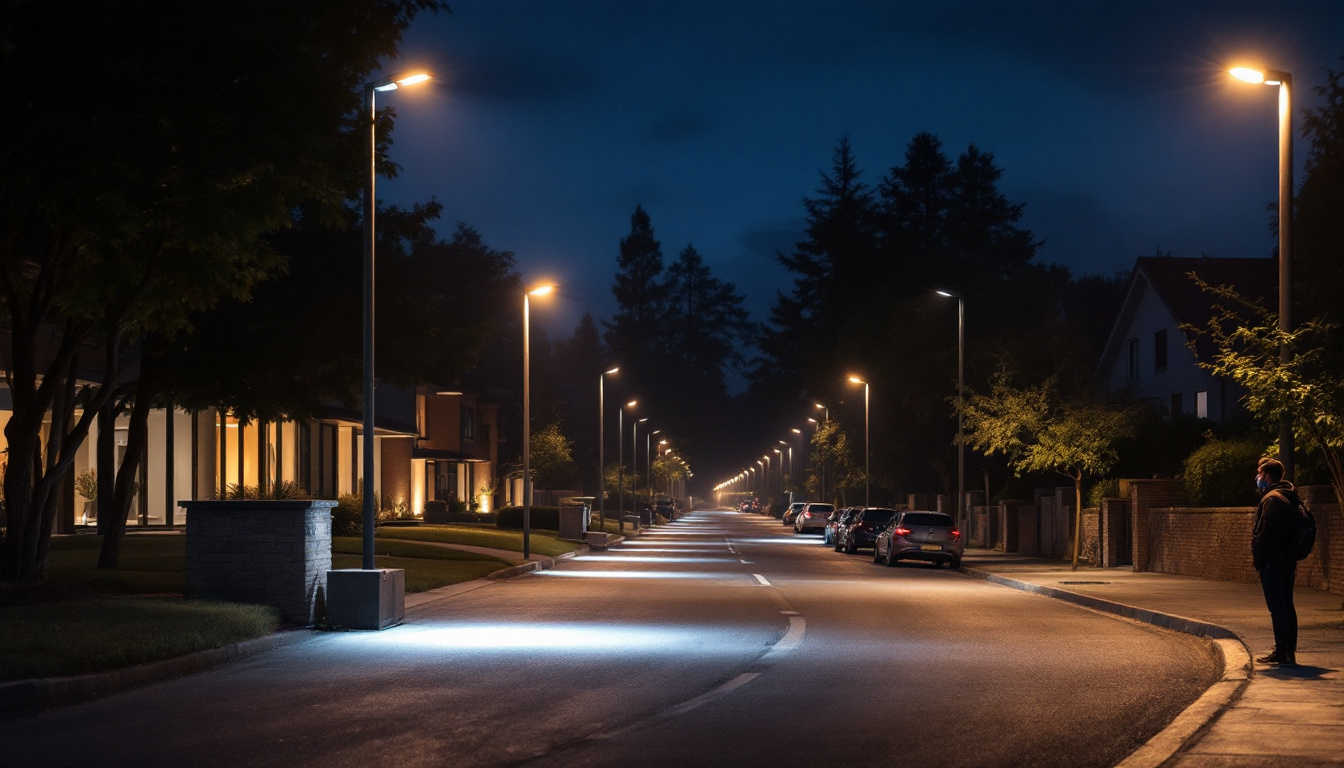
As the demand for sustainable and energy-efficient solutions continues to rise, solar sidewalk lights have emerged as a popular choice for lighting contractors. These innovative fixtures not only reduce energy costs but also enhance the aesthetic appeal of outdoor spaces. This article delves into best practices for lighting contractors when working with solar sidewalk lights, ensuring optimal performance and customer satisfaction.
Solar sidewalk lights are designed to illuminate walkways, pathways, and other outdoor areas using solar energy. They typically consist of solar panels, LED lights, and batteries that store energy for nighttime use. Understanding the components and functionality of these lights is essential for contractors looking to install them effectively.
The primary components of solar sidewalk lights include solar panels, batteries, LED bulbs, and the fixture housing. The solar panels collect sunlight during the day, converting it into electricity. This electricity is then stored in batteries, which power the LED lights when the sun sets. The fixture housing protects these components from environmental elements, ensuring durability and longevity. Additionally, many modern solar sidewalk lights come equipped with sensors that can detect ambient light levels, allowing them to turn on automatically at dusk and off at dawn, optimizing energy use and extending battery life.
Solar sidewalk lights offer numerous advantages, making them an attractive option for contractors and clients alike. Firstly, they are energy-efficient, reducing electricity costs significantly. Secondly, they are easy to install, often requiring no wiring or electrical connections. This not only saves time but also minimizes installation costs. Lastly, solar lights contribute to environmental sustainability by utilizing renewable energy sources. Beyond these benefits, solar sidewalk lights also enhance safety and security in outdoor spaces. By illuminating dark pathways, they help prevent accidents and deter potential intruders, creating a safer environment for pedestrians and residents. Furthermore, their aesthetic appeal can enhance the overall look of a property, with various designs available to complement different architectural styles and landscaping themes.
Before installation, a thorough site assessment is crucial. This process involves evaluating the location, determining the best light placement, and considering factors such as sunlight exposure and pedestrian traffic. Proper planning ensures that the solar sidewalk lights will function effectively and meet the needs of the space. Additionally, it is important to take into account the aesthetic aspects of the environment, ensuring that the lights complement the surrounding architecture and landscape. This not only enhances the visual appeal but also encourages community engagement and use of the space during evening hours.
One of the most critical aspects of installing solar sidewalk lights is assessing sunlight exposure. Ideally, solar panels should receive direct sunlight for a minimum of six hours each day. Contractors should observe the site throughout the day to identify any potential obstructions, such as trees or buildings, that could cast shadows on the solar panels. Furthermore, understanding seasonal changes in sunlight can also be beneficial, as the angle and intensity of sunlight can vary significantly throughout the year. This knowledge allows for better long-term performance predictions of the solar lights, ensuring they remain efficient even during less sunny months.
Strategic placement of solar lights is essential for maximizing illumination. Contractors should consider the width of the sidewalk, the height of the fixtures, and the desired brightness level. A common guideline is to space the lights approximately 10 to 15 feet apart, depending on the light output and the specific requirements of the area. In addition to spacing, it is also vital to consider the type of light emitted by the fixtures. Warm white lights may create a welcoming atmosphere, while cooler white lights can enhance visibility and safety. Furthermore, incorporating smart technology, such as motion sensors, can optimize energy use by adjusting brightness based on pedestrian activity, thereby extending the lifespan of the solar lights and reducing maintenance costs.
With a variety of solar sidewalk lights available on the market, selecting the right fixtures can be daunting. Contractors should consider several factors, including brightness, battery capacity, and design. Understanding these elements will help ensure the lights meet the project’s needs and client expectations.
The brightness of solar sidewalk lights is measured in lumens. For walkways and pathways, lights typically range from 50 to 200 lumens. Contractors should assess the specific requirements of the area to determine the appropriate lumen output. Areas with higher foot traffic or safety concerns may require brighter lights, while residential settings may benefit from softer illumination. Additionally, it’s essential to consider the color temperature of the light, as warmer tones can create a more inviting atmosphere, while cooler tones may enhance visibility and security.
Battery capacity is another critical factor to consider. The size and quality of the battery will influence how long the lights can operate after sunset. Contractors should choose lights with batteries that can provide sufficient runtime, especially in areas with extended nighttime hours or during cloudy weather. A good rule of thumb is to select lights with batteries that can last at least 8 to 10 hours on a full charge. Furthermore, it’s beneficial to look for solar lights equipped with advanced battery technologies, such as lithium-ion, which often offer better performance and longevity compared to traditional lead-acid batteries.
Design is not just about functionality; it also plays a crucial role in the overall aesthetics of the space. Solar sidewalk lights come in various styles, from sleek modern designs to more traditional lantern-like fixtures. Contractors should consider the architectural style of the surrounding environment and choose lights that complement the overall look. Moreover, the materials used in the construction of the lights can affect their durability and maintenance. Stainless steel and high-quality plastics are often preferred for their resistance to rust and fading, ensuring the lights remain attractive over time.
Installation is another key consideration when selecting solar sidewalk lights. Many models are designed for easy setup, requiring no wiring or professional assistance, which can save time and labor costs. However, contractors should ensure that the lights are installed in areas that receive adequate sunlight throughout the day to maximize charging efficiency. Regular maintenance is also essential; while solar lights generally require less upkeep than traditional lighting, periodic cleaning of the solar panels and checking for any obstructions can significantly enhance their performance and lifespan. Understanding these maintenance needs can help contractors provide better service and ensure client satisfaction.
Once the appropriate solar sidewalk lights have been selected, the installation process begins. Following best practices during installation is essential to ensure optimal performance and longevity of the fixtures.
Before installing the lights, contractors should prepare the site by clearing debris and ensuring a level surface. This preparation prevents potential damage to the fixtures and allows for proper drainage. Additionally, it’s essential to mark the locations for the lights based on the previously determined placement strategy.
Properly securing the solar sidewalk lights is vital for their stability and performance. Depending on the design, fixtures may need to be anchored into the ground or mounted on existing structures. Contractors should follow the manufacturer’s instructions for securing the lights to ensure they withstand environmental conditions, such as wind and rain.
While solar sidewalk lights require less maintenance than traditional lighting systems, regular upkeep is still necessary to ensure their longevity and efficiency. Contractors should educate clients on maintenance best practices and how to troubleshoot common issues.
Dust, dirt, and debris can accumulate on solar panels, reducing their efficiency. Contractors should recommend that clients clean the solar panels regularly, ideally every few months. A simple wipe with a damp cloth can significantly improve the lights’ performance by allowing maximum sunlight absorption.
Occasionally, solar sidewalk lights may experience issues, such as dim lighting or complete failure. Contractors should advise clients on how to identify these problems. Common troubleshooting steps include checking the battery condition, ensuring the solar panel is clean, and verifying that the light is not obstructed by nearby objects. If issues persist, consulting the manufacturer’s guidelines or seeking professional assistance may be necessary.
Beyond functionality, solar sidewalk lights can enhance the aesthetic appeal of outdoor spaces. Contractors should consider design elements that complement the surrounding environment while providing adequate illumination.
Solar sidewalk lights come in various designs, from modern sleek fixtures to more traditional styles. Contractors should work with clients to select designs that align with the overall theme of the space. For instance, contemporary landscapes may benefit from minimalist designs, while historical areas might call for fixtures that reflect classic architecture.
As technology advances, integrating smart features into solar sidewalk lights has become increasingly popular. Options such as motion sensors, dimming capabilities, and remote control functions can enhance both security and energy efficiency. Contractors should stay informed about the latest smart technologies available in solar lighting to offer clients innovative solutions.
Examining successful installations of solar sidewalk lights can provide valuable insights for contractors. These case studies illustrate the effective application of best practices and the benefits of solar lighting in various settings.
In a recent project involving a city park, contractors installed solar sidewalk lights along the main pathways. By conducting a thorough site assessment, they identified optimal placement that ensured maximum sunlight exposure. The result was a well-lit pathway that enhanced safety for evening visitors while maintaining the park’s natural aesthetics.
Another successful installation took place in a residential community where contractors replaced traditional lighting with solar sidewalk lights. By selecting fixtures with a warm glow, they created a welcoming atmosphere for residents. The project not only reduced energy costs but also improved the overall appeal of the community.
Solar sidewalk lights represent a forward-thinking solution for lighting contractors aiming to provide sustainable and efficient lighting options. By understanding the components, conducting thorough site assessments, selecting the right fixtures, and following best installation practices, contractors can ensure successful projects that meet client expectations.
Moreover, by staying informed about maintenance, troubleshooting, and design options, contractors can enhance their service offerings and contribute to the growing trend of eco-friendly lighting solutions. Embracing solar technology not only benefits clients but also supports a more sustainable future for outdoor lighting.
Ready to elevate your lighting projects with sustainable and efficient solar sidewalk lights? At LumenWholesale, we provide lighting contractors with the highest quality, spec-grade lighting products at unbeatable wholesale prices. Say goodbye to local distributor markups and hello to our extensive selection that meets rigorous industry standards. With free shipping on bulk orders, you can trust that you’re getting premium lighting solutions at the best value — no hidden fees, no compromises. Enhance your outdoor lighting projects with the perfect blend of quality, affordability, and convenience. Explore our collection now and secure Wholesale Lighting at the Best Value.

Discover how to enhance your home’s ambiance and safety with stairway ceiling lights.

Discover the hidden potential of solar-powered outdoor lanterns that many lighting contractors miss.

Explore the transformative role of boardwalk lighting in shaping the projects of lighting contractors.

Discover the ultimate guide to selecting the best flood lights with our essential checklist tailored for lighting professionals.